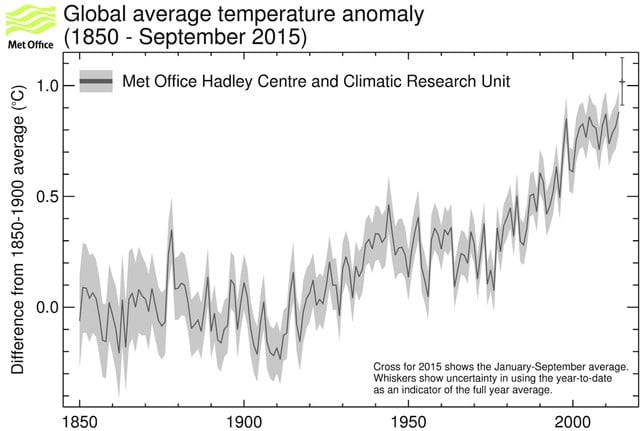Scientists expect 2015 to be the first year where global annual average temperature passes 1C above pre-industrial levels.
As of the end of September, global temperature is sitting at 1.02C above the 1850-1990 average, and is “expected to hold” for the rest of the year, a short Met Office report says.
This is another piece of evidence of “systematic warming” of the Earth’s climate, says Dr Peter Stott, head of the climate monitoring and attribution at the Met Office Hadley Centre.
The news generated some media interest, including headlines in the BBC and Guardian. It comes on the same day as the World Meteorological Organisation announced that the global average concentration of carbon dioxide surpassed 400 parts per million in spring 2015, notes the Independent.
‘Important marker’
Each year, major meteorological organisations around the world calculate the global average surface temperature. It’s just one measure of how the world is changing in response to human-caused greenhouse gas emissions.
These provisional figures for 2015 come from HadCRUT4, a dataset of observed global temperatures jointly put together by the UK Met Office and the Climatic Research Unit (CRU) at the University of East Anglia.
The data suggests that 2015 will reach, and surpass, 1C above pre-industrial temperatures for the first time in human history. The cross in the top right-hand corner of the chart below shows where the 2015 temperature currently sits compared to the last 150 years.

Hitting 1C is a significant point, Prof Stephen Belcher, Director of the Met Office Hadley Centre, said in a press conference at the Science Media Centre today:
“Given the United Nations target to reduce warming below 2C, this is an important marker in that, for the first time, we’ve passed halfway.”
2C is the internationally agreed limit above which the impacts of climate change are deemed to become intolerably high.
An ‘extra push’
In any one year, natural fluctuations in the climate can dampen or enhance the ongoing rise in global temperatures caused by human activity.
An El Niño, like the event currently underway, tends to give a short-term boost to surface temperatures. This is likely to be contributing to 2015 being such as warm year, said Stott at today’s press conference:
“There’s been an extra push from El Niño; nevertheless the fact is we have human influence driving our climate into uncharted territory, because we are now above 1C.”
The amount of warming that humans are contributing to global temperature rise is being tracked as part of the Oxford Martin School’s Safe Carbon project at the University of Oxford. Of the around 1C we’re seeing, the researchers have calculated that about 0.9C is attributable to humans (note a different baseline period to the Met Office analysis). Natural variability, including climate phenomena such as El Niño, make up the rest. As Prof Myles Allen, director of the Safe Carbon project, puts it:
“There’s two things going on here: there’s the natural variability and there’s the background trend, which is largely – overwhelmingly – driven by human influence on the climate.”
It’s worth noting that if 2015 does cross the 1C threshold, natural fluctuations in the climate system mean we shouldn’t automatically expect the next few years to cross it as well. However, it won’t be long before it becomes the norm, says Dr Ed Hawkins, Associate Professor at the University of Reading. He tells Carbon Brief:
“It is likely that global mean temperature in 2015 will be more than 1C above pre-industrial levels. This is obviously a significant symbolic milestone. Although temperatures in 2015 have been boosted by a strong El Niño event, it is only a matter of time until this temperature level is reached more permanently.”
Two-thirds
While we may be halfway to 2C of surface warming, we’ve long passed the halfway point in terms of the total allowable emissions to stay within a 2C limit, Belcher explains:
“In order to a good chance of staying below 2C, the best estimate is that we need to emit less than 2,900 gigatonnes of carbon dioxide into the atmosphere. The latest figures, which end last year, tell us that we’ve emitted 2,000 gigatonnes since pre-industrial, so we are two-thirds of the way to emitting the greenhouse gas emission budget to limit us to below 2C.”
According to the Intergovernmental Panel on Climate Change (IPCC), keeping to a carbon budget of 2,900 gigatonnes (billion tonnes) of carbon dioxide would give us a 66% chance of limiting global temperature rise below 2C.
Individual countries have recently been been submitting their pledges to the UN, setting out how far they intend to reduce their greenhouse gas emissions ahead of the negotiations in Paris next month. Various assessments of these pledges suggest they are currently too low to stay below the 2C limit without heavy reliance on negative emissions technology.
Source: Carbon Brief. Reproduced with permission.








